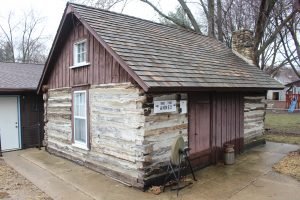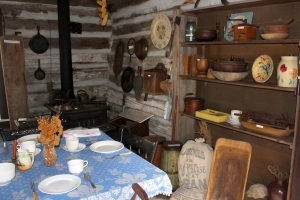Ole Anderson (aka Anundson) Skare emigrated from near Vradal village in Kviteseid Township of Telemark Province, Norway, to McFarland, Wisconsin, with his parents and one of his brothers in 1853. At first, Ole went by the name Ole Anderson, then Ole Anundson, and later, Ole A. Skare.
Ragnild Dalen (aka Dahlen) emigrated with her parents and three brothers from near Amotsdal village in Seljord Township of Telemark Province to the Koshkonong region near the boarder of Dane and Jefferson Counties in 1857.
Ole and Ragnild marry and have children
Ole Anderson Skare and Ragnhild Dalen were married at the West Koshkonong Norwegian Lutheran Church in Christian Township of Dane County on May 25, 1866. They made their home and raised their children on their farm off what is now Hidden Farm Road southeast of McFarland.
Ole and Ragnhild had 12 children but four died in infancy. Nine of their 12 children were born in the log cabin that now stands behind the McFarland Museum at 5814 Main Street. Of the nine, three children died in infancy so there was a brief period when six children lived in the little log cabin. Most of his children took Skare as their surname, but two chose to use the name Anderson.
Ole and Ragnhild Skare’s one room log cabin built around 1860 saw the birth of their children Haege, Julia, Caroline, Hanna, Albert and Herman, and three who did not survive infancy.
The family moves to a frame house
Their youngest sons–Gerhard, Robert, and another who died in infancy–were born in the family’s large frame house that replaced the cabin.
Albert inherits the property
Albert Skare continued to farm the land for many years. He enjoyed collecting old farm tools and other antiques that he stored in this and one other log cabin on his property. Albert died in 1967 and his collection of over 1100 items was given to the McFarland Historical Society, providing a significant portion of the Society’s artifacts.
The cabin and 1100 artifacts move to downtown McFarland
The log cabin was moved from the Skare farm to the McFarland Museum in 1972 and the restoration was completed in 1973. Some of the Skare family household effects are displayed as well as other items appropriate to a Norwegian pioneer family living in their small, hand-made home.
The logs that have been squared off are original as this was the style for Norwegian log house builders. The house was taken apart, piece-by-piece and some of the logs were in very poor condition. During construction, these rotten logs were replaced with treated telephone poles that are round rather than square. Cedar shingles were commonly used for roofs in this area and the shingles on the Skare log cabin have been replaced with newer cedar shingles over the years. Cement rather than the original mud and rags, was used for mortar.






